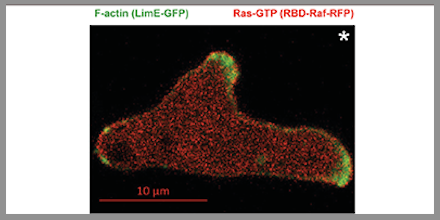Research Highlights
Prof. dr. Peter van Haastert

Mechanism of chemotaxis
Dictyostelium converts a shallow extracellular gradient of chemoattractant into a steep intracellular gradient of signaling molecules. This symmetry breaking in signaling is essential to enable the cell to migrate along a chemical gradient. This process, called chemotaxis, is necessary for processes as diverse as finding nutrients, wound healing and metastasis. Chemotaxis is highly complex and involves numerous signaling molecules and interconnected pathways. The van Haastert group identified a basal signaling module, consisting of heterotrimeric and monomeric G-proteins, which is essential to induce Dictyostelium chemotaxisa,b. Subsequently, a highly sensitive mass-pull-down proteomic strategy was applied to identify further components of this basal signaling pathway. Using 15 different bait proteins, several hundreds of interacting partners were found, many of which were previously unknown. New proteins involved in regulation of heterotrimeric G-protein signaling have been identified, and several candidates that might serve as missing links between heterotrimeric and monomeric G-protein signaling. Moreover, a number of proteins were identified that potentially form a direct link between heterotrimeric G-proteins and regulators of cytoskeletonc-e. We are currently using this efficient proteomic approach in combination with Yeast-2-hybrid screens to get further insights in the molecular mechanisms underlying the regulation of G-protein signaling and cytoskeleton during chemotaxis.
aEMBO Rep (2012); bJ Cell Sci (2013); cPNAS USA (2013); dMol Biol Cell (2015); eDev Cell (2016)
| Last modified: | 04 July 2017 10.12 a.m. |
